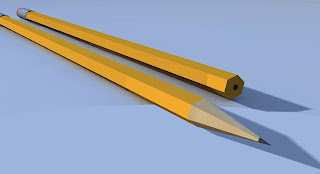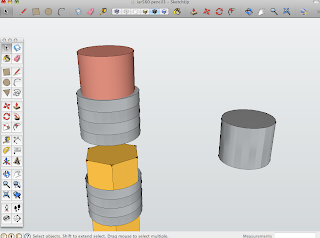After reading both articles, I have a new understanding for 3D modeling and everything that it consists of. After research I’ve come to find that there is so much more complexity to modeling than I knew about, yet more opportunity at the same time with all the different modeling programs and what they have to offer.
The purpose of 3D models is to use 3D geometry to define 2D and 3D shapes. These descriptions are then rasterized to create images for raster-based screens and printers. This is a very useful method for designers, architects, and mechanical engineers, especially when it comes to modeling their work to the best of its ability. However, there are challenges with 3D modeling programs and their unrealistic representations of day lighting and its effects on object surfaces.
Designers and model-makers have an important decision to make when deciding which features of the real object or other entity to incorporate in a 3D model. A good model captures information and relationships vital for a specific purpose, whether that purpose is functional or aesthetic (Building 3D Worlds pg.2). Today, scientific visualization allows visualizing a model in a 3D environment possible. Data from this model reveals information that would be nearly impossible to gather from looking at towering piles of numerical printouts (Building 3D Worlds pg3). There is also behavioral modeling, which gives the designer the ability to view an objects behavior in an environment, such as a stone falling to the ground if dropped, moving in an arc through the air when thrown, or colliding with other objects (Building 3D Worlds pg3). Artists and scientists still ponder the question of, when is a model good enough? A model should show 3D spatial information such as depth, but behavioral modeling and the modeling of other aspects of 3D reality, such as sound physical feedback, also can be important.
Visualization is the modeling of objects interiors. Objects interiors can be very useful for engineers and designers who want to understand the effects of stress or temperature on their materials. Advancements in computer-aided design have made 3D modeling possible for designers with voxel-based modeling. However, in order for voxel-based modeling to happen personal computers will need more memory, they will need faster algorithms for drawing voxel-based models on the screen, and better input and output devices are required (Building 3D Worlds pg5).
There are several important terms in the 3D modeling world that are important to know as designers, Boolean operation, primitives and sweeps. Boolean operations is adding and subtracting of shapes that can be performed with solid objects (Building 3D Worlds pg8). Primitives are 3D shapes that are not composed of any subsidiary 3D forms (and thus are usually quite simple). Primitives are pre-made and are defined in concise ways that take up less storage space. Programs use certain primitive shapes as useful starting points for creating components of more complex objects. Sweeps are Basic 3D forms, which can be created by drawing a 2D geometric shape, referred to as a profile, and then sweeping it through space to describe a 3D form (Building 3D Worlds pg7). All 3D programs understand polygons, and most 3D file-exchange formats are based on polygonal descriptions. For cube like forms with flat surfaces, a polygonal representation describes the desired shapes quite accurately. For curved forms, however, such spheres and cylinders, a polygonal representation can only approximate the desired surface. You can render polygonal models of curved objects to look smooth, but to model a curved surface more accurately you need real curved shapes, not linear approximations (Building 3D Worlds pg9).
To help make 3D modeling of real world objects easier, especially those in nature, which don’t look like a collection of geometric primitives or sweeps, digital clay and 3D sculpting have evolved. An approach to modifying simple objects called digital clay, or 3D sculpting (not related to volumetric sculpting), lets you click and drag on polygon vertices. By pushing and pulling on the vertices and connecting lines of objects polygonal mesh, you can warp a polyhedral object into various bent, twisted, and distorted new shapes (Building 3D Worlds pg10). Another useful tool for designers was the invention of Fractals. Many natural forms could not be described geometrically until the invention of fractals. Fractal objects mimic natural structures in a nonspecific way. Developed fractals as a geometric way to express seemingly irregular “non-geometric-looking” forms such as trees, coastlines, and clouds by noticing that they exhibited, at many levels of detail, patterns of self-similarity- the structure of a small section resembles the structure of the whole object (Building 3D Worlds pg16).
Particle systems is also a useful tool for designers, when it comes to modeling, for example, smoke, fire, air, bubbles, and the like which are not really single, distinct objects like a chair or a tree or self-similar structures like a plant, but can be thought of as dispersed particulate matter (Building 3D Worlds pg17). Such phenomena can be successfully represented with particle systems, or algorithmically controlled masses of individual shapes that are automatically created with hierarchies that can control movement of the entire system. (Building 3D Worlds pg18-19) Partical systems can be used to create natural forms such as plants and trees by defining the particles to look like branches, petals, or even parts of blades of grass.
Considering geometric modeling, a good data structure is one that is well formed, while balancing the attributes of generality, efficiency, and completeness in a manner that matches the needs of the application for which it is used. There are three general categories of geometric modeling, wire frames, surface models, and solid models. Wire frame models represent only the edges of shapes, leaving to the viewer the task of inferring the volume and other properties of the shape and form theses outlines. Surface models represent the vertices, edges, and faces of an object, but the structure they impose on these components is rather limited. They are relationships between the faces themselves; essentially collections of unrelated polygons (geometric modelingpg2). This approach supports hidden-line removal, the process where only those parts of the shape that are visible from a given point or view are displayed on the screen. Makes it possible to see the relationship between them. Lastly, solid models are the most complete, well formed, and general of all methods used to represent shapes. Its efficiency depends on the particular approach used to implement the model. Its surface, volume, and geometric properties can be calculated (geometric modelingpg3).
The use of these 3D modeling programs has evolved into something that designers and architects use daily to represent and communicate their work to their peers and the public. Without these programs, the modeling of complex structures would take far longer, and it would be much harder to visualize and express to other people. However, the difficulty of learning these programs is a downfall. Without the resources to be taught how to use these programs, trying to figure them out by yourself is nearly impossible. When you do know how to navigate these complex, 3D modeling programs you can get some extraordinary results and are very realistic.
Sources:
"Building 3D Worlds – 3D Geometric Graphics I" from The Computer in The
Visual Arts by Anne Spalter, Addison Wesley Longman Inc. 1999
On Geometric Modeling: Excerpt from “Modeling”. Architecture’s New Media by Yehuda Kalay, The MIT Press, 2004

















